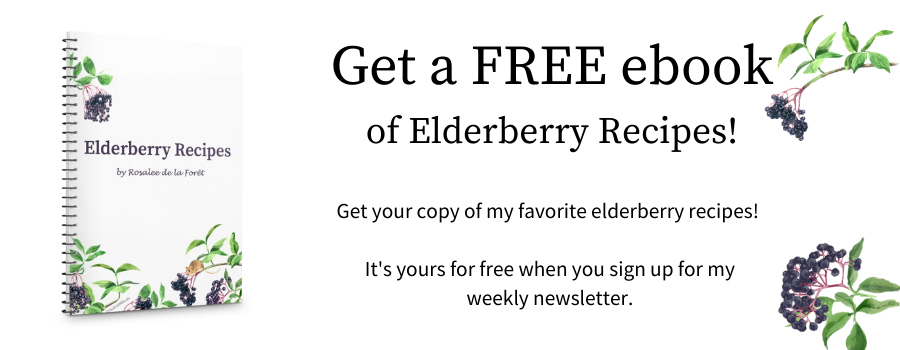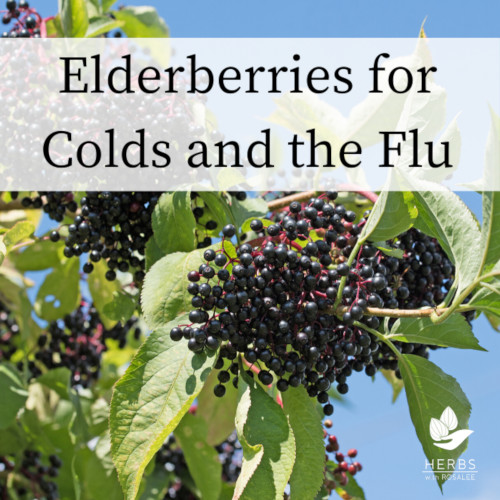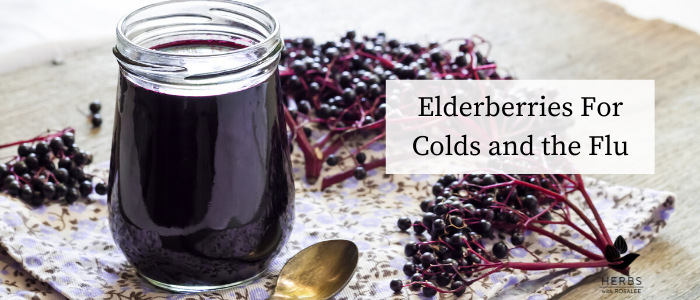Get weekly tips, recipes, and my Herbal Jumpstart e-course! Sign up for free today.

Elderberry for Colds
Share this! |
|
In my previous article I showed you the many benefits of using elderberry for colds and the flu (as well as the controversy regarding elderberry side effects and cytokines).
I love elderberry and often take it at the first sign of an illness! Not only has elderberry been shown to inhibit viral replication, it can also modulate the immune system.
In this article, I will show you how to best use elderberry for colds as well as recommended dosage and ways to prepare it.
How to Best Use Elderberry for Colds?
There are many ways to use elderberry. It is both medicine and food!
Wild foods enthusiasts eat elderberries regularly as jam, syrup, or wine. Some herbalists use elderberry as a preventive, taking it daily as a way to ward off illness.
My opinion is that daily use most likely has inflammation-modulating benefits; however, I choose to use it either as a food when desired (wine!) or when necessary to ward off a viral illness.
In other words, I take elderberry when I know I’ve been exposed to a virus or when I feel like I am coming down with something. I use it at the very first signs of illness, which can include that tell-tale tickle in the throat, feeling run down, or perhaps feeling feverish.
When I have those first warning signs that I am coming down with something, I drink strong infusions (teas) of elderberry frequently throughout the day. For example, I will make a quart of tea using 30 grams of elderberries and drink that throughout the day. This is a large dose! It’s what I’ve found gives me the best results.
Other herbalists find that smaller doses and different preparations of elderberry work well for them. Syrups and tinctures are popular.
Most herbalists agree that once symptoms progress past those first warning signs, elderberry becomes decreasingly helpful. I often take elderberry for several days in the beginning of an upper respiratory infection, but if I develop other symptoms such as a cough or fever, then I move on to other herbs that are more directed at those particular symptoms.
Click here to read an article where I’ve written more about Herbs for Viral Infections.

Should You Cook or Heat Elderberry for Colds?
Raw elderberries can cause nausea and even vomiting in some people.
Cooking, dehydrating, and/or heating the berries all diminish this effect without removing any of the medicinal qualities. Some people make tinctures with the raw berries, which doesn’t seem to be a problem.
What is the Dosage for Elderberry for Colds?
As I mentioned above, I tend to use elderberry in fairly high dosages for a short period of time.
When using elderberry at the onset of an illness, it’s most important to take it frequently throughout the day. Taking it only once in the day will most likely have little benefit.
When I mention dosage, I am talking about the dosage of the actual plant material.
To determine how much you should use of a given product or preparation, it’s best to consider the strength of the actual product.
For example, people will often ask how many cups of tea they should drink each day. In this case, the amount of water doesn’t matter as much as the quantity of herb used to make the tea. You could make a cup of tea with 1 teaspoon of berries or 1/4 cup of berries – those would be two very different preparations!
My best advice when using non-standard preparations is to use your taste buds to determine the strength. In other words, does it taste watery and weak? Or does it have a robust and strong taste? With safe, food-like herbs like elderberry, you want a strong flavor to have a good medicinal effect.
In this case, I often use up to 30 grams of dried elderberries per day to make a quart of robust tea. From there, use the tea in smaller or larger amounts, but still take it frequently throughout the day.
Many of the studies done on elderberry are using commercial preparations of elderberry syrup; for example, 15 mL of elderberry syrup four times a day. If you are using a commercial preparation, you will find dosage information on the label. (Keep in mind that commercial products often have lower dosages listed than what herbalists often use.)
Where Can I Find Elderberry for Colds?
In the Northern tier of North America, elderberries are ripe in the late summer and fall. In southern states, elderberry blooms twice each year, with berries ripe in May-June and September-October.
Learning to identify elderberry and harvest your own berries is a really great way to be in touch with your medicine. But not everyone will be able to harvest berries, and the wildlife often gets there first!
Due to elderberry’s popularity for winter respiratory complaints, it is more and more difficult to find dried berries or elderberry products on the market in the spring. Fall is the best time to purchase dried berries or elderberry products.
Check with your local apothecaries, herbalists, or health foods stores to see if they have elderberries or elderberry preparations in stock.
When I can’t find herbs locally, I buy them from Mountain Rose Herbs. At the writing of this article, they are out of stock on elderberries.
It may be that you simply won’t be able to find elderberry right now.
I would love to see more elderberry products available in the future. Here’s some ways we can support that:
1. Contact your local herb and vegetable farmers and tell them you’re interested in getting elderberries from them. Here’s a listing of local herb farmers in the US and Canada.
2. Elder shrubs are easy to grow from cuttings. If you have space, consider planting elderberry in your yard. When possible, plant the species that is native to your area. My friend Kami McBride has an article about how to grow elder from cuttings here.
Other Elderberry Benefits
Elderberry has many benefits that go beyond using them for colds. For more information about the many ways to use elderberry (include elder flowers), read what I wrote about elderberry benefits here.

Rosalee is an herbalist and author of the bestselling book Alchemy of Herbs: Transform Everyday Ingredients Into Foods & Remedies That Healand co-author of the bestselling book Wild Remedies: How to Forage Healing Foods and Craft Your Own Herbal Medicine. She's a registered herbalist with the American Herbalist Guild and has taught thousands of students through her online courses. Read about how Rosalee went from having a terminal illness to being a bestselling author in her full story here.

